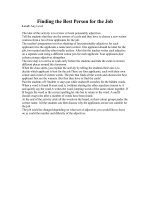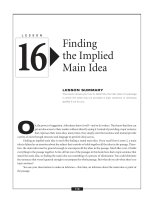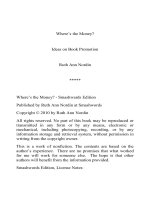Finding the Supporting Idea
Bạn đang xem bản rút gọn của tài liệu. Xem và tải ngay bản đầy đủ của tài liệu tại đây (86.67 KB, 12 trang )
67
CHAPTER
7
F
INDING THE
S
UPPORTING
I
DEAS
Because main ideas are
assertions, they need
support. This chapter
explains the types
of support writers use.
You’ll also learn how to
distinguish between
major and minor
supporting ideas, which
will help you focus on
what to remember.
T
he main idea of a paragraph is like an umbrella
that “covers” the rest of the sentences in the paragraph. The
other sentences in the paragraph offer support for the main
idea. But what exactly is that support? How does it work? And why does
it matter?
You might think of a piece of writing as a table. The top of the table
is the main idea—what the writer thinks, believes, or knows about her
subject. But the table won’t stand without legs to support it. In writing,
those “legs” are the specific facts and ideas that support the main idea.
They are the “proof” or “evidence” writers provide to show that their
main idea is valid.
READ BETTER
,
REMEMBER MORE
68
TYPES OF SUPPORT
Writers support their ideas in a variety of ways. They often use a combi-
nation of the following types of specific support:
•
details
•
facts
•
examples
•
explanations
•
definitions
•
comparisons
•
quotations
•
statistics
•
descriptions
•
reasons
For example, imagine you receive the following memo regarding
tuition reimbursement at work. Read it carefully and then look at the way
it is outlined below. The sentences are numbered to make the passage
easier to analyze.
(1) Due to increasing costs, there will be two changes in the
tuition reimbursement program that will significantly reduce
employee benefits. (2) First, reimbursement has been reduced
from 100 percent to 60 percent of tuition costs for each course
in which the student earns a “C” or better. (3) For example, if
you pay $1,000 for a course, and earn at least a C in that course,
you will be reimbursed in the amount of $600. (4) Second,
employees will now be limited to $2,000 in reimbursement
expenses per year. (5) Thus, if your tuition per course equals
$1,000, you will be reimbursed $600 per course for each of your
three courses but only $200 for the fourth course because you
will have reached the $2,000 limit. (6) Any additional courses in
that year will not be reimbursed.
This paragraph follows a very common pattern. It starts with the topic
sentence (sentence 1). Then it offers support for that topic sentence in
the form of details and examples. Sentences 2 and 4 give the details of the
FINDING THE SUPPORTING IDEAS
69
change in the tuition reimbursement program. Sentences 3, 5, and 6 give
specific examples of those changes. Thus, the organization looks like this
(sentence numbers are in parentheses):
Main idea (1)
Detail (2)
Example (3)
Detail (4)
Example (5, 6)
DISTINGUISHING MAIN IDEAS
FROM SUPPORTING IDEAS
If you’re not sure whether something is a main idea or supporting idea,
ask yourself whether the sentence is making a general statement or
providing specific information. In the tuition reimbursement memo,
notice how all of the sentences besides Sentence 1 are making very
specific statements. They are not general enough to serve as an umbrella
for the whole paragraph. Therefore, they must be working to support the
main idea.
Signal Words
You can often tell whether a sentence is expressing a main idea or provid-
ing support by looking for certain clues. Notice how each supporting
sentence from the memo begins:
Sentence 2: First, …
Sentence 3: For example, …
Sentence 4: Second, …
Sentence 5: Thus, …
These words and others like them are signal words: They tell you that
a supporting fact or idea will follow. The following list shows some of the
most common words and phrases that signal supporting ideas.
READ BETTER
,
REMEMBER MORE
70
Transitions
accordingly however next
also in additionon the other hand
as a result indeed secondly
first in fact since
first of all in other words specifically
for example inparticular then
for instance likewise therefore
furthermore nevertheless thus
These signal words and phrases are often called transitions. Transi-
tions are words and phrases that writers use to move from one idea to the
next. They show the relationships between ideas so
that readers can see how ideas are connected. In
other words, these transitions help show readers
how ideas work together to support the main idea
in a passage. For example, the transitional word
likewise shows that the ideas before and after it are
similar; they have something in common. The
transitional phrase for example tells readers that
what comes next is an example of what came before. That’s how transi-
tions work.
Sentence A likewise Sentence B
Shows that there are similarities
between the ideas in
Sentences A and B.
Sentence A for example Sentence B
Shows that Sentence B
provides an example of
the idea in Sentence A.
What are Transitions?
Transitions are words and
phrases that signal a shift
from one idea to the next
or show how ideas are
related.
FINDING THE SUPPORTING IDEAS
71
P
RACTICE
1
Read the paragraph below carefully. Underline any words or phrases that
signal a supporting idea.
Our new marketing campaign has been a tremendous
success. In fact, since we’ve been advertising on the radio,
sales have increased by 35%. Likewise, our client references
have doubled, and we’ve improved our client retention rates.
Furthermore, we’ve had to hire five new sales representatives
to meet demand.
Answer
Our new marketing campaign has been a tremendous
success. I
n fact, since we’ve been advertising on the radio,
sales have increased by 35%. Like
wise, our client references
have doubled, and we’ve improved our client retention rates.
F
urther
more, we’ve had to hire five new sales representatives
to meet demand.
Two Questions to Ask
To help you distinguish between main and supporting ideas, then, there
are two questions you can ask:
1
. Is the idea general enough to be a main idea, or is it a specific
detail?
2
. Is there a transitional word or phrase indicating that it’s probably a
supporting idea? Sometimes just one question will make it clear,
but be careful. Not every sentence will have a signal word or phrase
to tell you that it’s a supporting sentence. Also, you need to be care-
ful to distinguish which main idea a supporting idea actually
supports.
P
RACTICE
2
Read the following passage carefully and then answer the questions that
follow (the paragraphs are numbered to make the questions easier to
follow).









